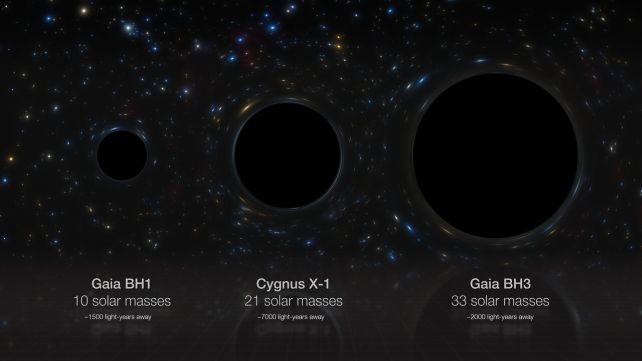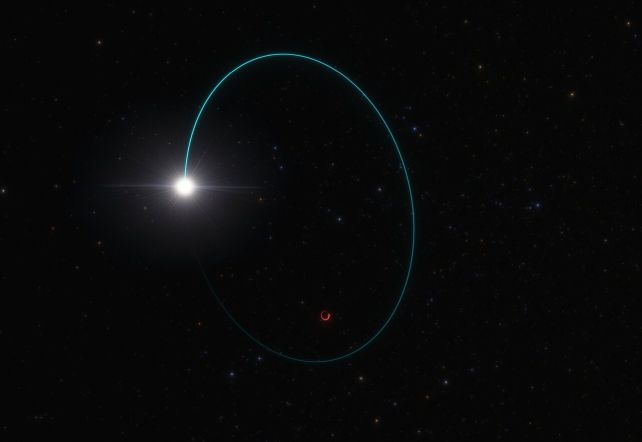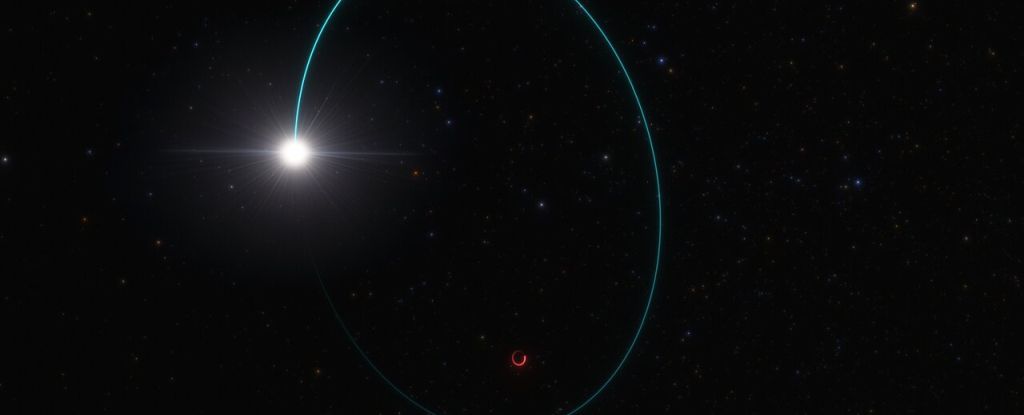Products You May Like
You never really know what you might find hiding in your own backyard, especially if those things are particularly adept at escaping detection.
Just 1,924 light-years from the Solar System, in the constellation of Aquila, astronomers have just discovered a black hole.
And it’s not just any black hole. Named Gaia BH3, or BH3, the object is the most massive stellar-mass black hole we’ve ever spotted in the Milky Way, clocking in at a hefty 33 times the mass of the Sun.
It’s the second-closest black hole we’ve found to our homeworld, and it’s just hanging out, quietly in space, minding its own black hole business. The only reason we know it’s there is because it’s in a binary orbit with a companion star whose motion can’t be explained any other way.
To be clear, BH3 poses absolutely no threat. A black hole’s gravitational field is no stronger than that of a star of equivalent mass, and BH3 is just doing its own thing. But as the third dormant black hole discovered in Gaia data, it does raise the question about how many more of these beasts are out there, zooming around undetected.

“No one was expecting to find a high-mass black hole lurking nearby, undetected so far,” says astronomer Pasquale Panuzzo of the National Centre for Scientific Research (CNRS) in France, member of the Gaia collaboration, and first author on the paper describing the object.
“This is the kind of discovery you make once in your research life.”
Black holes broadly fall into different mass categories. There are supermassive ones that can be millions to billions of times the mass of the Sun; those are usually found at the centers of galaxies, and we’re not sure how they form.
The smaller, stellar-mass ones form from the collapse of stellar cores when massive stars go supernova. These can be up to about 65 times the mass of the Sun (although larger ones can form from mergers).
frameborder=”0″ allow=”accelerometer; autoplay; clipboard-write; encrypted-media; gyroscope; picture-in-picture; web-share” referrerpolicy=”strict-origin-when-cross-origin” allowfullscreen>
Estimates put the number of stellar-mass black holes in the Milky Way at up to 100 million, but they’re not very easy to detect, since black holes famously don’t emit any light.
We might occasionally spot a flare from one if it slurps down some material from a passing or binary companion star, since that process generates a lot of heat. Otherwise, they just hang about being dormant and invisible. We’ve only found around 20 so far, with a few more candidates.
There are a few ways we can detect dormant stellar-mass black holes, and one of them involves not the black hole itself but any stars in companion orbits, close enough to be gravitationally bound to the black hole but not close enough to be devoured. These stars will move around oddly in space, describing an orbit with something we cannot see.
This is where Gaia comes in. A spacecraft sharing Earth’s orbit around the Sun, Gaia has been operational since 2013. It maps the three-dimensional positions and motions of stars in the Milky Way with the highest precision yet. The more time it spends staring at the stars, the more precise its measurements become.
The fourth Gaia data release isn’t expected before the end of 2025, but the discovery of BH3 as astronomers checked the data was too exciting to sit on.
“We took the exceptional step of publishing this paper based on preliminary data ahead of the forthcoming Gaia release because of the unique nature of the discovery,” says astronomer Elisabetta Caffau of the CNRS.

What we know about the system is that the two objects are separated by a distance of about 16 times the distance between Earth and the Sun, and orbit each other every 11.6 years. The black hole clocks in at about 32.7 solar masses.
The star, by contrast, is small, clocking in at just 76 percent of the Sun’s mass, but nearly five times its size. It’s very poor in heavy elements, a property that means it must be very old, since stars didn’t incorporate these elements into their formation until previous generations of stars had produced them and sprayed them out into the Universe.
The star also shows no sign of pollution from the material that the black hole precursor must have ejected as it went supernova, suggesting that the two came together in their orbital dance after the black hole had already formed.
Stars with cores large enough to form a black hole nearly 33 times the Sun’s mass are challenging to explain. However, models suggest that this can be achieved if the massive precursor star also had low metallicity.
Hopefully, the discovery represents a teaser of what is to come. The researchers anticipate finding even more black holes upon the fourth release of Gaia data.
The research has been published in Astronomy & Astrophysics.
